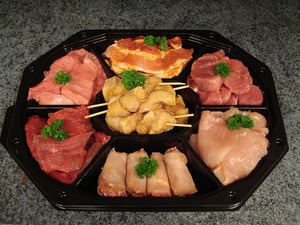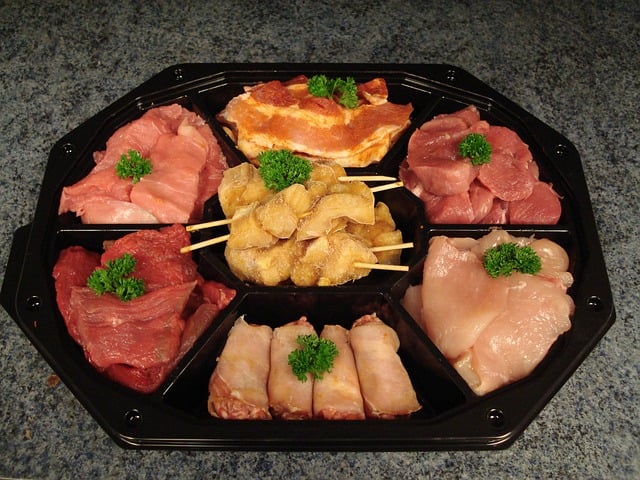Recently, UK consumers have been made aware that major supermarkets and fast food chains are selling halal meat, often unlabelled as such, and that this practice is fairly widespread, meaning that many non-Muslims have been eating halal foods without realizing it.
So far, the response to this revelation has been mixed. Some people are concerned about the welfare issues associated with the ritual slaughter practices necessary for halal meat production and there is a general sense of unease among parts of the non-Muslim population that the interests of a minority have been given precedence over those of the majority.

The British Veterinary Association has launched a campaign to end non-stun slaughter, with the support of the Royal Society for the Prevention of Cruelty to Animals. Ritual slaughter has recently been banned in Denmark, and is already prohibited in other countries, including Sweden and Poland. European Union regulations generally require animals to be pre-stunned, but allow exceptions to this rule for religious reasons, as does US legislation.
Ritual slaughter
In order for meat to be halal or kosher, it has to be obtained from animals slaughtered according to specific Muslim or Jewish ritual practices, known as dhabihah and shechita, respectively. In both procedures, a sharp, non-serrated blade is used to achieve a single cut across the neck that goes through the veins, arteries, trachea and oesophagus, followed by complete draining of the blood. For halal slaughter to be achieved, the name of Allah must be pronounced before the slaughter of each animal, whereas in shechita, a blessing is recited before an uninterrupted period of slaughter of more than one animal.
Stunning
In conventional western slaughterhouses, animals are stunned prior to slaughter, to render them unconscious and incapable of feeling pain. In many countries, including the UK, stunning is mandatory prior to sticking, the process in which the animal’s throat is cut. Penetrative captive bolts are often fired into the heads of large animals, such as cattle, sheep and pigs, in order to stun them.
Alternatively, calves, sheep and pigs may be subjected to electrical stunning, in which a large pair of tongs is used to pass an electrical current through the brain, leading to temporary loss of consciousness. Pigs and poultry can also be stunned by exposure to high concentrations of gas, and poultry can be shackled upside down, allowing their heads to enter an electrical stunning water bath.
Before Jewish slaughter, the animal has to be healthy and capable of independent life, and shechita has to be the effective cause of the animal’s death; therefore, none of the stunning methods employed before secular slaughter are allowed. However, some Muslim authorities state that stunning prior to halal slaughter is permissible, as long as it is not the direct cause of the animal’s death. In the UK, over 80% of halal meat is derived from animals stunned during slaughter, and in a few cases, this is stated on food labels.
Animal welfare
The amount of suffering caused by slaughter in the absence of pre-stunning is a matter of considerable debate. Attempts to determine this have focused on the time taken for an animal to collapse after the cut has been made, as well as bleed out volume and rate, time to brain failure measured by electroencephalogram, presence of blood in the respiratory tract and occurrence of false aneurysms in the severed carotid arteries, which can arrest blood flow out of the body, allowing it to continue flowing to the brain and prolong consciousness.
Many of these experiments have indicated that pre-stunning may reduce suffering. For example, a study was conducted by Gregory et al in which 174 cattle were subjected to halal slaughter without pre-stunning whilst being restrained in the upright position. Immediately after the cut was made the animals were released from the restraint. 8% of them failed to collapse within 60 seconds, and 71% of cattle that took >75 seconds to collapse exhibited false aneurysms in the carotid arteries.
However, a detailed review of the behavioural and physiological responses of slaughter animals to shechita, conducted by cardiologist, Stuart Rosen, concluded that the method was a painless, rapid and effective means of stunning and killing an animal in a single act. He also suggested that some of the stunning methods used prior to sticking in non-religious slaughter may not be as humane as they appear to be.
Consumer attitudes
Little evidence exists to suggest that meat quality, including flavour, colour and texture, are influenced to any significant extent by slaughter method. Of course, to Muslim and Jewish shoppers, the halal or kosher nature of the meat is often in itself a major quality attribute with a hugely positive impact on purchasing behaviour.
Perhaps the key question that should be asked is: does the average non-Muslim or Jewish consumer care whether animals are religiously slaughtered or not? A recent survey of 1,977 British consumers carried out by YouGov for The Grocer magazine suggested that just over 50% of meat eaters were prepared to buy religiously slaughtered meat in some form and that 68% would not pay more to guarantee that their meat was not obtained from animals subjected to ritual killing. The same study showed that younger consumers tended to be more relaxed about the issue than their older counterparts.
Perhaps this, together with the possibility that food service operators and retailers may find it cheaper to provide only halal meat, rather than offer consumers a choice, and the fact that halal meat is often derived from stunned animals, reducing welfare concerns, means that halal meat is about to emerge into the mainstream and become the default “option” for all meat eaters.
(Image Credit: Fransvanhoek at www.pixabay.com)


